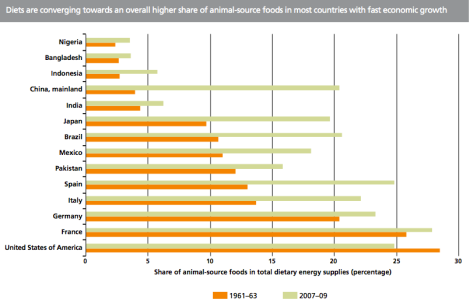
ShutterstockThe sort of food that is not helping things.
Here’s a good news / bad news sort of thing. I guess we’ll start with the good news, because that won’t take as long.
Good news
In 2009, the United Nations announced that 1 billion people around the world experienced on-going, persistent hunger. The good news is: that estimate was high! From the AP:
The United Nations said Tuesday its 2009 headline-grabbing announcement that 1 billion people in the world were hungry was off-target and that the number is actually more like 870 million.
The U.N. Food and Agriculture Organization blamed flawed methodology and poor data for the bum projection, and said it now uses a much more accurate set of parameters and statistics to calculate its annual estimate of the world’s hungry. …
And the good news, FAO said, is that the number of hungry people has actually been declining steadily – rather than increasing – over the past two decades…
Good news! 130 million fewer people living in hunger than we thought!
Bad news
870 million people around the world live in hunger.
The trend is bad: According to the FAO report, progress in reducing hunger has “slowed and levelled off” since 2007 – 2008. By 2050, demand for food is expected to increase by 60 percent. Which is to say, for every 100 calories the world requires now, it will by then require 160.
Somewhat remarkably, the U.N. report mentions climate change only in passing:
Given climate change, natural resource constraints and competing demands, especially for the production of biofuels, among other factors, [increased food demand] presents a considerable challenge for the agriculture and food systems worldwide.
The threat of climate change to food supplies deserves more attention than that. A 2009 report from the World Food Program suggested that:
By 2050, the number of people at risk of hunger as a result of climate change is expected to increase by 10 to 20 percent more than would be expected without climate change; and the number of malnourished children is expected to increase by 24 million — 21 percent more than without climate change. Sub-Saharan Africa is likely to be the worst affected region.
The World Watch Institute suggests how that might come about.
Higher temperatures are expected to reduce crop yields, allow damaging weeds and insects to spread, and shift precipitation patterns worldwide. While some agricultural regions are expected to benefit from climate change, overall production will decline for the world’s rice, wheat, maize, millet, and sorghum harvests, the report said.
For examples of how higher temperatures impact crop yields and allow the spread of insects, please see all of our drought coverage from this summer.
Most severely affected will be the wheat-growing regions of South Asia, Europe and Central Asia, and sub-Saharan Africa, where production is projected to decline by 46, 47, and 35 percent, respectively. Also under threat are Middle Eastern rice paddies, where production is expected to fall by 36 percent.
One increasing trend will make the impacts of climate change even worse: more meat-eating. According to the U.N. report, the shift toward meat consumption has been significant over the past 50 years.
More meat, as we’ve mentioned before, means more water use and more land required to produce grain to feed the animals. Not what a warming world needs.
In conclusion
At Grist, we like to end on a positive note when we can.
I guess I should have started with the bad news.





